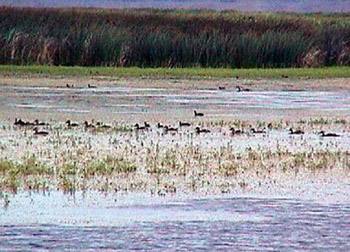McFarland Ranch and Refuge Project
 |
| Lake County, OR |
The McFarland Ranch and Refuge encompasses 3000 acres of prime waterfowl habitat along the northwest shore of Goose Lake in Lake County, Oregon. The property also contains roughly 3 miles of Drew's Creek, and 3 miles of Drew's Slough, plus hundreds of acres of wet meadow habitats. The property, formerly managed for cattle grazing and grain production, now will be restored to fish and wildlife habitat, with 1000 acres under perpetual WRP easement. Restoration activities will include replacing the push-up dam with a large water control structure that will provide fish passage, screening the diversion ditch, and creating a spilllway capable of passing flood flows. Project partners include the landowners, DU, Natural Resource Conservation Service, Oregon Department of Fish and Wildlife, Oregon Watershed Enhancement Board, and US Fish and Wildlife Service.
Native plant communities, especially along Drew's Creek and Drew's Slough have been severely degraded by livestock use. A large push-up irrigation diversion on Drew's Creek was installed several decades ago to irrigate the northeastern portions of the ranch. This diversion has no provisions for fish passage or screens to prevent fish from being diverted from the stream along with irrigation water.

During high flow events the structure is frequently overtopped and subsequently breached, resulting in severe downstream channel erosion and incision. There are also several hundred acres of wetlands that were enhanced long ago by the creation of low berms. These berms contained small water control structures capable of passing irrigation water, but incapable of passing flood flows. Portions of these berms and some of the structures have failed, draining some of the most productive weltand acres on the property.
Restoration activities will include replacing the push-up dam with a large water control structure that will provide fish passage, screen the diversion ditch, and creating a spillway capable of passing flood flows. Many of the existing water management structures are in disrepair, and will be replaced, and several new structures will be added to maximize waterfowl benefits. Fences will be built to exclude cattle, and several miles of streams will be revegetated. Restoration is planned for summer of 2003.
Ducks Unlimited uses cookies to enhance your browsing experience, optimize site functionality, analyze traffic, and deliver personalized advertising through third parties. By continuing to use this site, you agree to our use of cookies. View Privacy Policy